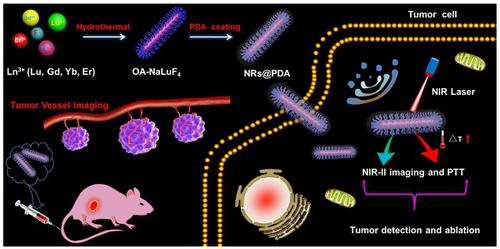当前位置:
X-MOL 学术
›
Theranostics
›
论文详情
Our official English website, www.x-mol.net, welcomes your
feedback! (Note: you will need to create a separate account there.)
Polydopamine coated multifunctional lanthanide theranostic agent for vascular malformation and tumor vessel imaging beyond 1500 nm and imaging-guided photothermal therapy.
Theranostics ( IF 12.4 ) Pub Date : 2019-01-01 , DOI: 10.7150/thno.31864 Xiaolong Li 1 , Mingyang Jiang 1 , Songjun Zeng 1 , Hongrong Liu 1
Theranostics ( IF 12.4 ) Pub Date : 2019-01-01 , DOI: 10.7150/thno.31864 Xiaolong Li 1 , Mingyang Jiang 1 , Songjun Zeng 1 , Hongrong Liu 1
Affiliation

|
The optical imaging guided tumor vessels and vascular malformation visualization by using the second near infrared emission beyond 1500 nm (NIR-II) is emerged as the next generation fluorescence imaging technique for early tumor diagnosis and identification of tumor-associated vascular features. On the other hand, developing theranostic probes for NIR-II imaging guided photothermal therapy (PTT) is of great significance, which is rarely explored. Herein, a high performance theranostic nanoplatform based on the core-shell structured NaLuF4 nanorods@polydopamine (denoted as NRs@PDA) by integrating the new advanced NIR-II imaging beyond 1500 nm with PTT function was developed for tumor-associated vascular malformation visualization and imaging-guided PTT. Methods: In this work, the hydrophilic NaLuF4 NRs@PDA therapeutic probe was synthesized by using a reverse microemulsion method. The crystal phase, morphology, emission spectra and photothermal performance of the synthesized samples were systematically characterized. The NIR-II optical imaging and photothermal properties were investigated by in vitro and in vivo experiments. Results: The NaLuF4 NRs@PDA therapeutic probe possessed efficient NIR-II emission centered at 1525 nm with high quantum yield (QY), good photo-stability and high biocompatibility. In vivo NIR-IIb imaging based on the designed probe can clearly visualize the whole-body vessel and brain vessel with high spatial resolution, especially tumor-associated vessels. In addition, in vitro and in vivo experiments also demonstrated that the designed NaLuF4 NRs@PDA probe possessed efficient photothermal conversion efficiency (40.18%) for PTT ablation of tumor. Conclusion: With the excellent NIR-II imaging ability and PTT of tumor, the designed theranostic nanoplatform successfully realize the simultaneous tumor vessel diagnosis and tumor therapy, which may provide the opportunity of designing new theranostic bioprobes with combination of the NIR-II optical imaging technique and PTT function for tumor diagnosis and therapy.
中文翻译:

聚多巴胺包被的多功能镧系元素治疗剂,可用于血管畸形和1500 nm以上的肿瘤血管成像以及成像引导的光热疗法。
光学成像引导肿瘤血管和使用超过1500 nm的第二个近红外发射(NIR-II)可视化血管畸形,已成为下一代荧光成像技术,用于早期肿瘤诊断和肿瘤相关血管特征的识别。另一方面,开发用于NIR-II成像引导光热疗法(PTT)的治疗诊断探针具有重要意义,这很少被探索。在此,通过结合超过1500 nm的新型先进NIR-II成像和PTT功能,开发了基于核壳结构NaLuF4纳米棒@聚多巴胺(表示为NRs @ PDA)的高性能治疗药物纳米平台,用于肿瘤相关血管畸形的可视化和成像引导PTT。方法:在这项工作中,采用反相微乳液法合成了亲水性NaLuF4 NRs @ PDA治疗探针。系统地表征了合成样品的晶相,形貌,发射光谱和光热性能。通过体外和体内实验研究了NIR-II光学成像和光热性能。结果:NaLuF4 NRs @ PDA治疗探针具有以1525 nm为中心的高效NIR-II发射,具有高量子产率(QY),良好的光稳定性和高生物相容性。基于设计的探针的体内NIR-IIb成像可以清晰地可视化具有高空间分辨率的全身血管和脑血管,尤其是与肿瘤相关的血管。此外,体外和体内实验还表明,所设计的NaLuF4 NRs @ PDA探针具有有效的光热转换效率(40.18%),可用于肿瘤的PTT消融。结论:具有优异的NIR-II成像能力和肿瘤的PTT,设计的治疗性纳米平台成功实现了肿瘤血管的同时诊断和肿瘤治疗,这为结合NIR-II光学成像技术设计新型治疗性生物探针提供了机会。和PTT功能可用于肿瘤的诊断和治疗。
更新日期:2019-01-01
中文翻译:

聚多巴胺包被的多功能镧系元素治疗剂,可用于血管畸形和1500 nm以上的肿瘤血管成像以及成像引导的光热疗法。
光学成像引导肿瘤血管和使用超过1500 nm的第二个近红外发射(NIR-II)可视化血管畸形,已成为下一代荧光成像技术,用于早期肿瘤诊断和肿瘤相关血管特征的识别。另一方面,开发用于NIR-II成像引导光热疗法(PTT)的治疗诊断探针具有重要意义,这很少被探索。在此,通过结合超过1500 nm的新型先进NIR-II成像和PTT功能,开发了基于核壳结构NaLuF4纳米棒@聚多巴胺(表示为NRs @ PDA)的高性能治疗药物纳米平台,用于肿瘤相关血管畸形的可视化和成像引导PTT。方法:在这项工作中,采用反相微乳液法合成了亲水性NaLuF4 NRs @ PDA治疗探针。系统地表征了合成样品的晶相,形貌,发射光谱和光热性能。通过体外和体内实验研究了NIR-II光学成像和光热性能。结果:NaLuF4 NRs @ PDA治疗探针具有以1525 nm为中心的高效NIR-II发射,具有高量子产率(QY),良好的光稳定性和高生物相容性。基于设计的探针的体内NIR-IIb成像可以清晰地可视化具有高空间分辨率的全身血管和脑血管,尤其是与肿瘤相关的血管。此外,体外和体内实验还表明,所设计的NaLuF4 NRs @ PDA探针具有有效的光热转换效率(40.18%),可用于肿瘤的PTT消融。结论:具有优异的NIR-II成像能力和肿瘤的PTT,设计的治疗性纳米平台成功实现了肿瘤血管的同时诊断和肿瘤治疗,这为结合NIR-II光学成像技术设计新型治疗性生物探针提供了机会。和PTT功能可用于肿瘤的诊断和治疗。










































 京公网安备 11010802027423号
京公网安备 11010802027423号